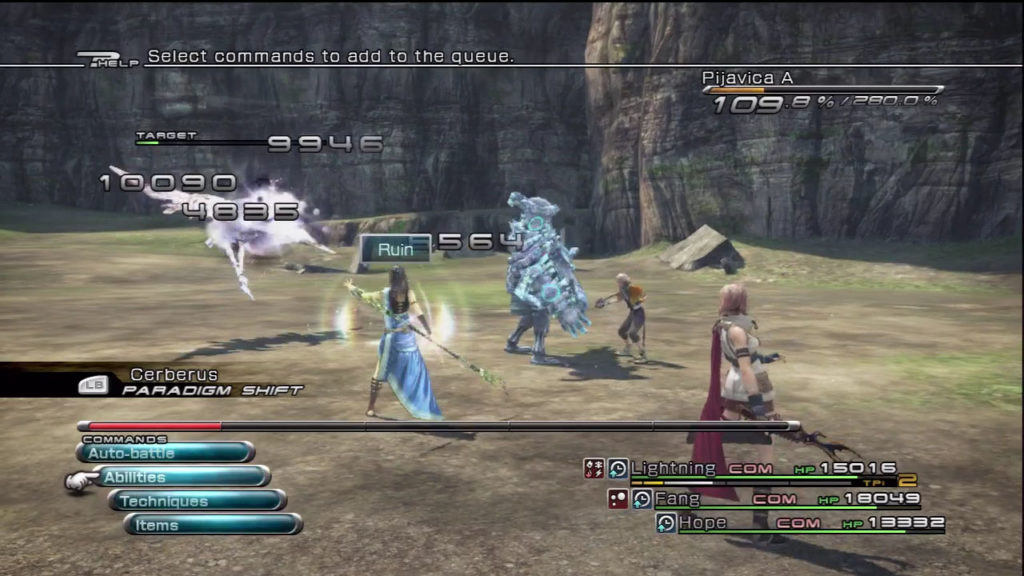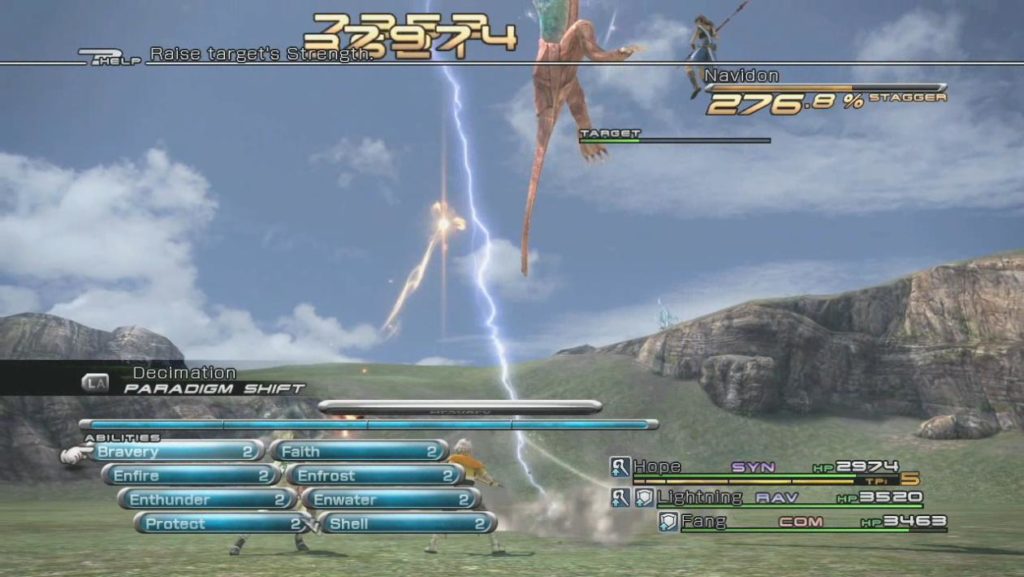Last updated on May 3, 2016
Part 2
Unfortunately, Final Fantasy XIII lacks a “hook” in the narrative sense. If you’re not used to this sort of story, or simply dismiss it as “JRPG” schlock, I wouldn’t blame you. My irrational enjoyment of the Final Fantasy series usually powers me through the initial few hours, because I want to see what the developers throw at you next, but it’s not true that most people will make it through those initial hours if at all. Final Fantasy XIII is still a JRPG at heart, and it’ll take many hours (probably 40, give or take) to really get a hold of this plot and this world, to simply drink in the (amazingly still) beautiful sights and sounds of the Tubular World.
If you’re wondering why I keep mentioning The Tube, the entire game’s structure feels like that. The game makes no pretensions about being linear, displaying it proudly and openly at every opportunity. You run, you fight a battle, you run, you fight a battle, and so on. While consistently thematically (because, surprise, the characters need to run away from the forces that want to kill them as they try to figure out their Focus), some might find it very, very repetitive or patronizing to have elements of the game doled out at such a slow pace. If you never liked JRPG fighting, then Final Fantasy XIII will certainly never light your fire, although maybe I can change your mind…
The thing is, Final Fantasy XIII is one of the purest games I’ve played in recent memory. It makes no pretensions to hide the artifice of it being a video game, instead wholly embracing the fact that it’s truly all about its battle system. The Tube allows the game to progress the plot, while also making the player fight battles at fixed intervals. In my view, The Tube exists to supplement the battle system by placing a distinctly placed and marked series of challenges within its constraints. In that way, the game’s surprisingly consistent at pacing its various intense normal encounters and boss battles throughout , and I don’t think I’ve seen a game with a more varied set of challenges within a single battle system.
 The Command Synergy Battle system remains a curious, engaging, and unique concept, despite the fact I just played through Final Fantasy XIII a second time. To explain: all enemies are visible in the field. When the player runs into them, the screen shifts to the start of a battle where the player can control one character out of a party of up to three (as with most games in the series, you eventually get the ability to choose which character you control, and who’s in your party). You can get a pre-emptive strikes, which has hidden benefits (which are explained below), so entering into these battles in the right way can sometimes be crucial.
The Command Synergy Battle system remains a curious, engaging, and unique concept, despite the fact I just played through Final Fantasy XIII a second time. To explain: all enemies are visible in the field. When the player runs into them, the screen shifts to the start of a battle where the player can control one character out of a party of up to three (as with most games in the series, you eventually get the ability to choose which character you control, and who’s in your party). You can get a pre-emptive strikes, which has hidden benefits (which are explained below), so entering into these battles in the right way can sometimes be crucial.
The Active Time Battle gauge returns from previous entries, though here it’s clearly “real time” management than anything else. Each command, including physical and magic attacks, has a numeric value referred to as “ATB Cost” next to the name indicating how many of these sections it will take up. Note that every single normal action in the game’s battles uses this currency, and you’ll be using these a lot. The purpose of such attacks isn’t to simply deal physical or magic damage, however; simply hitting enemies in this game usually doesn’t deal much damage.
There’s a clear, and defined, purpose to all such attacks in the form of the Chain Gauge. Each enemy has a specific Chain Gauge length, and it fills as the player performs attack combos marked by a percentage. Once you fill the gauge up to its maximum, the enemy enters “Stagger Mode”, which increases the damage caused by your party’s attacks. Staggered enemies can be launched in the air and juggled with attacks, which prevents them from acting – and trust me, you’ll need it. Most encounters require juggling multiple enemies with multiple Chain Gauges, requiring a ton of multitasking and the like; having one of them launched into the air and focused-fired is a blessing, but you could just as easily be killed by the other enemies.
 Note previously that I mentioned you control ONE character out of a party of three; the other two are controlled by the AI, and mostly to good effect. Battles move FAST, very fast, and that makes it impossible to control all three at once. Instead of controlling a full party and its actions, you can only really deal with one characters when battles continually progress; as such, the Command Synergy Battle system introduces the concept of the “Paradigm Shift” (known as “Optima Change” in Japan). Each character in your party inhabits one of six different roles which you mix and match into “Paradigm Deck”, which are any conglomeration of the three roles as a unit.
Note previously that I mentioned you control ONE character out of a party of three; the other two are controlled by the AI, and mostly to good effect. Battles move FAST, very fast, and that makes it impossible to control all three at once. Instead of controlling a full party and its actions, you can only really deal with one characters when battles continually progress; as such, the Command Synergy Battle system introduces the concept of the “Paradigm Shift” (known as “Optima Change” in Japan). Each character in your party inhabits one of six different roles which you mix and match into “Paradigm Deck”, which are any conglomeration of the three roles as a unit.
Each of those roles fits into a specific archetype, and is useful for various functions. The Commando is your physical attacker, whose attacks delay the drain of the Chain Gauges, and also deal massive damage based on the percentage level of the Chain Gauge. They are the ones who Launch enemies into the air as well – however, they can’t really cause the Chain Gauge to increase very much. Enter Ravagers, your typical magic users who can cast a variety of elemental and area-of-effect attacks; they raise the Chain Gauge quite fast, but also cause the Gauge to drain significantly faster. Obviously, you’ll need a mix of Commandos and Ravagers to output any kind of damage and Chain Gauge filling.
However, just offense will often get you killed in Final Fantasy XIII. You definitely need to pick your spots, and supplement that offense with the other roles. Sentinels act as the “tank” of the group, focusing the enemy’s fire on one particular person in the party. Usually Sentinels take very little damage, so this leaves other party members free to do what they will, either attacking, healing, or some other function. Medic is your traditional healer, restoring HP as well as removing status effect. Unlike in more traditional Final Fantasy games, status effects, both buffs and debuffs, are incredibly helpful and dangerous in equal measure. Medics will cast Esuna a LOT, and getting rid of Slow, Deprotect, and Deshell ASAP is almost necessary at times. The Synergist class acts as your buffing class, allowing you to cast the opposite such spells – Haste, Protect, Shell – and a bunch of other helpful augmentations (casting them also removes negative debuffs, which is a nice bonus). You can also use debuffs against enemies with the Saboteur, who can wreck an enemy party with any lack of immunity towards spells (like, say, Death).
